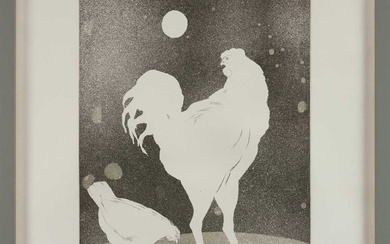λ Dame Elisabeth Frink (British 1930-1993), Small Dog
λ Elisabeth Frink (British 1930-1993)Small DogBronze with a brown patina Signed and numbered 4/10 (on the base)24 x 28cm (9¼ x 11 in.)Conceived in 1986.Provenance:The Everard Read Gallery, Johannesburg, South AfricaPrivate Collection, London (acquired from the above by the present owner)Thence by descent to the present ownersLiterature:Annette Ratuszniak, Elisabeth Frink Catalogue Raisonné of Sculpture 1947-93, London, 2013, p. 175, no. 358, illustration of another cast 'The particular attraction for me is that dogs are the animals who've been closest to man for thousands of years. I find that interesting.' Elisabeth Frink, quoted in Edward Lucie-Smith and Elisabeth Frink, Frink: A portrait, Bloomsbury, London, 1994, p. 50 The topic of man's best friend was explored by Frink during the late 1980s and early 1990s. Whilst dogs and their relationship with man had always fascinated the artist it was during her time spent at her home at Woolland in Dorset that sparked the inspiration for this series. Alex Csaky, Frink's husband owned Hungarian gun-dogs and it was these majestic hounds whose strong muscular build and smooth coats could be transferred to sculpture. In the same year that Small Dog (FCR358) was created Frink produced Large Dog (FCR355) a life-size study of the Hungarian Vizsla. What is particularly striking is the characterful face, wide eyes and large nose which captures the charming features of 'man's best friend', as the dog appears to look up towards the viewer almost in awe of its owner. During this same period Frink visited Leonardo Da Vinci's Chateau de Cloux. At the entrance to the chateau are two stone dogs, awaiting the return of their master. These two sculptures inspired Frink who created life-size versions titled Leonardo's Dog I and Leonardo's Dog II in 1991 and 1992 respectively. Small Dog (FCR 358) has the same charming facial features, with its ears pushed back and its glossy smooth coat worked into the surface of the enchanting sculpture. Frink was unapologetic for her interest in dogs whilst others around her were producing pieces for the esoteric . Frink's Dog series was not made to be scrutinised and nor did they open discussion of critical interpretation. They developed a direct engagement with the public by producing a subject matter she was interested in. Condition Report: In overall good condition. Some minor surface dirt, some ingrained to the crevasses. Would benefit from a light clean. Condition Report Disclaimer
[ translate ]View it on
Sale price
Estimate
Time, Location
Auction House
λ Elisabeth Frink (British 1930-1993)Small DogBronze with a brown patina Signed and numbered 4/10 (on the base)24 x 28cm (9¼ x 11 in.)Conceived in 1986.Provenance:The Everard Read Gallery, Johannesburg, South AfricaPrivate Collection, London (acquired from the above by the present owner)Thence by descent to the present ownersLiterature:Annette Ratuszniak, Elisabeth Frink Catalogue Raisonné of Sculpture 1947-93, London, 2013, p. 175, no. 358, illustration of another cast 'The particular attraction for me is that dogs are the animals who've been closest to man for thousands of years. I find that interesting.' Elisabeth Frink, quoted in Edward Lucie-Smith and Elisabeth Frink, Frink: A portrait, Bloomsbury, London, 1994, p. 50 The topic of man's best friend was explored by Frink during the late 1980s and early 1990s. Whilst dogs and their relationship with man had always fascinated the artist it was during her time spent at her home at Woolland in Dorset that sparked the inspiration for this series. Alex Csaky, Frink's husband owned Hungarian gun-dogs and it was these majestic hounds whose strong muscular build and smooth coats could be transferred to sculpture. In the same year that Small Dog (FCR358) was created Frink produced Large Dog (FCR355) a life-size study of the Hungarian Vizsla. What is particularly striking is the characterful face, wide eyes and large nose which captures the charming features of 'man's best friend', as the dog appears to look up towards the viewer almost in awe of its owner. During this same period Frink visited Leonardo Da Vinci's Chateau de Cloux. At the entrance to the chateau are two stone dogs, awaiting the return of their master. These two sculptures inspired Frink who created life-size versions titled Leonardo's Dog I and Leonardo's Dog II in 1991 and 1992 respectively. Small Dog (FCR 358) has the same charming facial features, with its ears pushed back and its glossy smooth coat worked into the surface of the enchanting sculpture. Frink was unapologetic for her interest in dogs whilst others around her were producing pieces for the esoteric . Frink's Dog series was not made to be scrutinised and nor did they open discussion of critical interpretation. They developed a direct engagement with the public by producing a subject matter she was interested in. Condition Report: In overall good condition. Some minor surface dirt, some ingrained to the crevasses. Would benefit from a light clean. Condition Report Disclaimer
[ translate ]


![The Miller's Tale I; The Miller's Tale II (from The Canterbury Tales I, 1970) [HERS AND HIS BAWDY BUTTS] The Miller's Tale I; The Miller's Tale II (from The Canterbury Tales I, 1970) [HERS AND HIS BAWDY BUTTS]](https://gcp-la8-storage-cdn.lot-art.com/public/upl/57/The-Millers-Tale-I-The-Millers-Tale-II-from-The-Canterbury-Tales-I-1970-HERS-AND-HIS-BAWDY-BUTTS_1604237600_5440-thumb.jpg)


